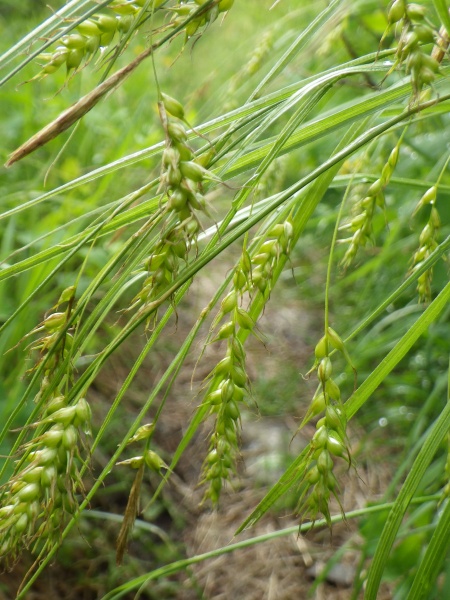
Source: Matt Lavin
Carex sprengelii
Sprengel's Sedge
Carex de Sprengel
Synonyms
long-beaked sedge
Seeds in stock
Available at table Shade
Available at table Shade
We currently accept seeds for this plant
Bloom Colour: Green
Bloom Period: May - Jul
Max Height: 2.0 feet
Max Width: 1.0 feet (spreads by rhizome)
Light Condition:
 Less than 2 or 3 hours of direct sun a day
Soil conditions:
Less than 2 or 3 hours of direct sun a day
Soil conditions:
 Tolerates medium soil condition
Tolerates medium soil condition
 Less than 2 or 3 hours of direct sun a day
Less than 2 or 3 hours of direct sun a day
 Tolerates medium soil condition
Tolerates medium soil condition
Lifespan:
Perennial
plants that will that come back year after year
Gardener Experience:
 Suitable for beginner gardeners
Suitable for beginner gardeners
 Does not spread uncontrollably
Does not spread uncontrollably
 Self-seeding
Self-seeding
 Suitable for beginner gardeners
Suitable for beginner gardeners
 Does not spread uncontrollably
Does not spread uncontrollably
 Self-seeding
Self-seeding
Landscape Uses:
 Suitable for rock gardens
Suitable for rock gardens
 Suitable for Right of Way gardens
Suitable for Right of Way gardens
 Suitable for container garden
Suitable for container garden
 Suitable for school gardens
Suitable for school gardens
 Suitable for woodland gardens
Suitable for woodland gardens
 Tolerates boulevard garden conditions
Tolerates boulevard garden conditions
 Suitable for rock gardens
Suitable for rock gardens
 Suitable for Right of Way gardens
Suitable for Right of Way gardens
 Suitable for container garden
Suitable for container garden
 Suitable for school gardens
Suitable for school gardens
 Suitable for woodland gardens
Suitable for woodland gardens
 Tolerates boulevard garden conditions
Tolerates boulevard garden conditions
Ecological Benefits:
 Supports birds
Supports birds
 Supports birds
Supports birds
Tolerates:
 Deer resistant
Deer resistant
 Rabbit resistant
Rabbit resistant
 Tolerates foot traffic around the plant
Tolerates foot traffic around the plant
 Tolerates juglone conditions
Tolerates juglone conditions
 Tolerates transplantation
Tolerates transplantation
 Deer resistant
Deer resistant
 Rabbit resistant
Rabbit resistant
 Tolerates foot traffic around the plant
Tolerates foot traffic around the plant
 Tolerates juglone conditions
Tolerates juglone conditions
 Tolerates transplantation
Tolerates transplantation
Special Features and Considerations:
 This plant is a GRASP candidate
This plant is a GRASP candidate
 This plant is a GRASP candidate
This plant is a GRASP candidate
Plant Location
Native to Ottawa region: Yes
Distribution according to VASCAN

Ephemeral
Native
Introduced
Excluded
Extirpated
Doubtful
Absent
Thrives in Ecozones
- Boreal Plains
- Boreal Shield
- Mixed Wood Plains
Ecological Benefits
Butterflies Supported by Carex sprengelii
No butterfly data available for this plant.
Specialized Bees Supported by Carex sprengelii
No bee data available for this plant.
Plants that grow in similar conditions, that bloom at the same time.
Complementary Plants
- Blephilia hirsuta
Hairy Wood Mint
Bléphilie hirsute - Clinopodium vulgare
Wild Basil
Sarriette vulgaire - Persicaria pensylvanica
Pennsylvania Smartweed
Renouée de Pennsylvanie - Phryma leptostachya
American Lopseed
Phryma à épis grêles - Symphyotrichum shortii
Short's Aster
Aster de Short
Substitute For Non-Native Plants
- Pennisetum setaceum (Fountain Grass)
Sowing Information
Download Seed Envelope Labels (PDF)
- Sowing depth: Surface sow
- Sow by February
- Stratification duration: 60 days
- Self-seeding
Harvesting and Seed Sharing
- Harvest start month: June
- Harvesting indicator:
- Seeds easily fall off when you gently pull them off
- Harvesting:
- Use hand to detach from main stem
- Seed viability test:
- No test needed before donating
- Packaging measure: A dozen (12) seeds (eyeball)
- Seed storage:
- Air dry in paper bag or open container, for a few days until crisp
- Shake seeds to move them once in a while to prevent molding
- Cultivar: No, you can donate without knowing the source as there are only straight species
- Harvesting video: Watch here
Toxicity Notes
Inadequate information on toxicity found.
GRASP Candidate
Overlooked or difficult to grow plants (eg ghost plants, shrubs, trees, complicated germination etc); sapling sitters, seed sitters, skilled germination, growers with right conditions- aiming for local stock; these plants may not be extinct, but overlooked OR support habitat OR support a vulnerable animal/insect.


 Canadensis
Canadensis
